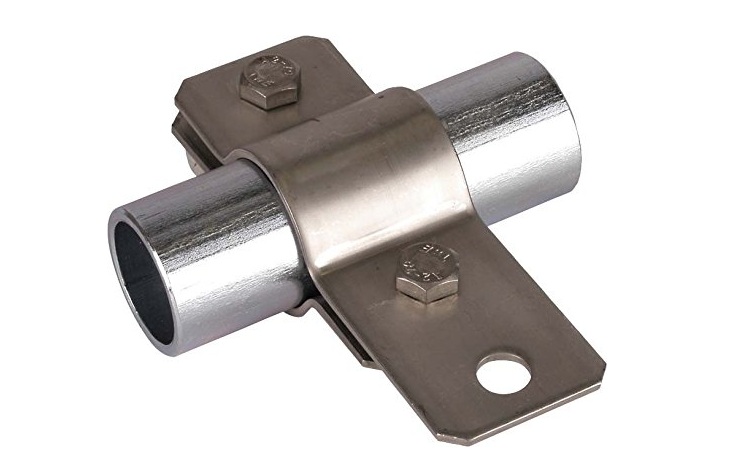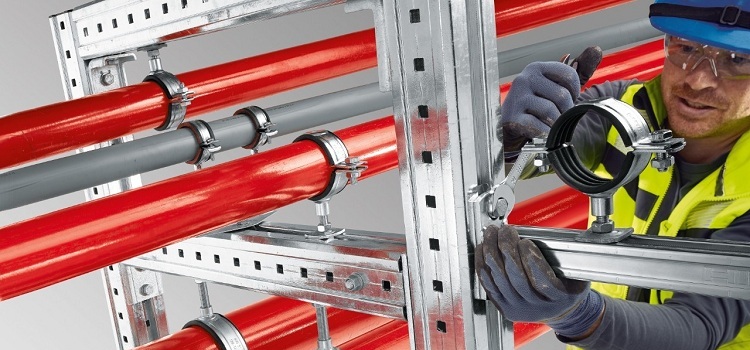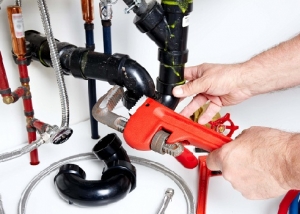Pipe mounts are fixtures that allow you to fix the pipeline on a work surface (such as a wall). Such devices are used when laying all communications without exception: water pipes, heat pipes, gas pipelines, sewer systems, etc. The choice of fasteners depends on the type of pipeline design and the features of the gasket.
Content
Fixing pipes with clamps
Today, the use of clamps for attaching the pipeline to the wall is one of the most common methods. This is due to the versatility of such fasteners. By means of clamps, it is possible to carry out installation not only of small diameter pipes, but also of large-sized structures.
The design of the clamp includes several basic elements, among which:
- half rings;
- special sealing gaskets;
- an element that fixes the hairpin;
- screw stud.
Half rings. These elements can have a different cross-sectional indicator, depending on the characteristics of the communication being laid. In half rings, the pipe is fixed. The main advantage of these products is that they are joined together by screws - this allows you to adjust their cross-sectional index.
Gaskets. They are made of rubber and are used for better adhesion of the pipe to the clamp. Another function of these products is the damping of vibrational vibrations that occur during transportation of the working medium through the pipeline.
Pin lock. As a rule, this element is connected to one of the rings by welding and is necessary to secure the studs.
Screw stud. The length of such screws varies from 8 to 18 cm and is selected in accordance with the characteristics of the laid communication.
Note! The main advantage of using pipe clamps is the reliability of the structure. Of the minuses of these devices, it can be noted that they have an unpresentable appearance.
Consider the sequence of securing communication using clamps:
- Perform marking on which the clamps will be installed.
- Organization of holes.
- Mounting clamps.
- Pipe fasteners.
Fixing pipes with plastic clips
Polymer clips are devices by means of which metal-plastic and plastic pipes are fastened. Most often, clips are used to organize the fastening of heating pipes to the wall, as well as when installing water pipes from polymeric materials.
Clips are made from a material called polystyrene. Polystyrene is characterized by high strength characteristics and is resistant to adverse conditions, which allows for reliable fastening.
Clips can be of two types:
- single;
- double.

Double clips are convenient for installation of a water supply system when pipes of hot and cold water are located nearby
Double clips are most often used when laying water structures.This is due to the fact that their use allows fixing both water supply lines (hot and cold). The use of double products not only simplifies the installation of water pipes, but also speeds up this process. From individual single clips, you can perform a single design. The assembly of clips among themselves allows for special grooves that are located on the product.
The cross-sectional index of the clips ranges from 16 to 50 mm, so they are ideal for installation of household communications. Clips can have clips or integral units equipped with a dowel. Products of the second type are the easiest to mount.
The algorithm for fastening pipes to the wall through these elements is as follows:
- First of all, on the wall, it is necessary to make markings that will correspond to the location of the fasteners. The distance between the clips is calculated in advance and determined taking into account the characteristics of a particular pipeline.
- At the second stage, the preparation of holes for the clips is made. To organize the holes you need a hammer drill with a drill. The drill cross section can be 8 or 10 mm, depending on which dowels are used for mounting clips.
- Next, the fasteners are mounted to the wall using dowels.
- In the end, it remains to fix the pipe in the clips.
Using clamps
The fastening of pipelines by means of clamps is very similar to the previous installation option, however, such fasteners have some features that are worth paying attention to:
- The main difference between clips and clips is that the former are distinguished by a closed version of the design. Thus, when fixing the pipe, you first need to open the latch, and after that the pipe clicks in it. The mounted design is more reliable and durable. Such pipe fittings are ideal if it is necessary to fix a communication section located in a vertical plane to the wall;
- today in the construction market you can find two types of such devices. The first type includes products in which the self-tapping screw is connected directly to the dowel and pipe fastening. In the second case, the part that clamps the pipe does not fit with the self-tapping screw, which allows you to freely remove the pipe from the clamp;

The clip is a closed version of the clip, in order to put a pipe into it, you need to open the upper part - the clamp
Note! When purchasing a pipe clamp, it is recommended to pay attention to the quality of the latches.
- There is a separate type of clamps, which differs in that it does not have a dowel. For such products, you need to purchase a dowel separately. The main advantage of these clamps is low cost, so the purchase of such devices will save on the installation of the pipeline.
Most often, clamps are used for fastening metal-plastic communications, which need reliable fixation on the work surface. The installation of these fasteners practically does not differ from the installation of clips, however, differences in the design of the clamp require its preliminary opening.
Fastening the pipe to the wall with brackets
A bracket is another device that allows you to reliably fix communication on a work surface. These products are made of galvanized steel, so they are characterized by high strength characteristics and a long service life. Steel brackets are used in situations when it is necessary to ensure reliable fastening of pipelines. The strength of the bracket is directly proportional to the thickness of the steel.
All staples are divided into two main varieties:
- two-armed;
- P-shaped.
From a structural point of view, the two-arm model is the simplest. It is made in the form of a curved metal strip, equipped with eyes on each side. In the metal eyes are ready-made holes for dowels or screws.The cross-sectional indicator of brackets is selected depending on the type of communication.

The two-lap bracket provides reliable fixation of the pipe thanks to two points of attachment to the surface
Unlike the previous model, the P-shaped or one-foot brace has two ends combined in an eye. The R-shaped model is used to fix pipes and hoses, as well as corrugated pipes. The cross-sectional index of P-shaped staples ranges from 10 to 120 mm. Such brackets are used in cases where fasteners are not affected by large loads.
Staples can be equipped with sealing elements that are made of rubber. Regardless of which fixative product is used when laying the pipeline structure, the sealing elements perform the same functions: enhance the adhesion of the device to the pipe and damp out unwanted vibrations in the system.
Installation of these devices is quite simple. Moreover, the working surface, on which it is necessary to fix the pipeline, can be either concrete or wooden. To fix the staples on a wooden work surface, it is not necessary to use dowels, since in this case ordinary self-tapping screws are also suitable.
Methods of fastening pipes
Fixing the pipe structure to the wall is carried out in two main ways. Consider them:
- hard;
- free (floating).
A hard fixation option is used for various communications, including:
- water pipes (hot and cold);
- heat pipes;
- sewer systems.
A feature of the rigid fixation of pipes to the wall is that communication is completely blocked. Thus, the pipeline is deprived of the ability to move during thermal expansion. In this case, the connecting fitting plays the role of a supporting element.
A free fixation method involves the use of clamps or any other fasteners that are mounted so that there is free space between the outer surface of the pipe and the inner surface of the retainer. Free space allows the pipe to move. To organize the indentation from the wall, special elements are used - brackets. An arm is a locking element used when installing pipes in a vertical plane.
Which method to choose for the installation of the heating system? Installation of heating communication is a serious undertaking, therefore, the selection of the method of fixing pipes must be selected taking into account the following rules:
- An important role in choosing the method of fixing heat transport communication is played by temperature differences. If the room is heated, then there is no need to be afraid of temperature changes and the fixed (rigid) option of fixing the pipes is used. The absence of temperature differences eliminates the possibility of moving pipes along its axis;
Important! The fixed fixation of the heat conduit is made in strictly defined places, namely: bends, turns, as well as the points at which the corresponding fittings are attached.
- the floating method is used in cases where the room temperature does not reach the required level, that is, there is a possibility of thermal expansion of the diameter of the pipes.
Another way that allows not only to fasten, but also to hide pipes, which allows to increase the usable space of the room, is a closed laying of communication. Such installation is carried out in the walls, where using a special tool for cutting, channels (strobes) for pipes are made. Hiding pipes in a wall or partition is not such a common method as outdoor installation. This is due to the fact that such work requires more financial costs.Another disadvantage of a closed gasket is the difficulty in determining the breakdown and repair of communication.
The method of fixing pipes is selected depending on the features of the pipeline design, as well as on the preferences of the owners. If necessary, you can consult a specialist to determine the installation method.








